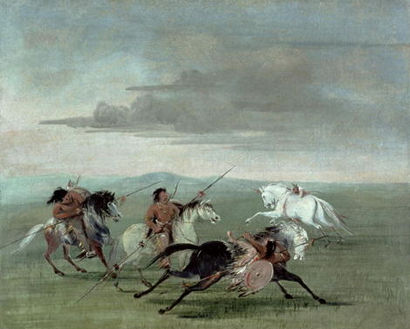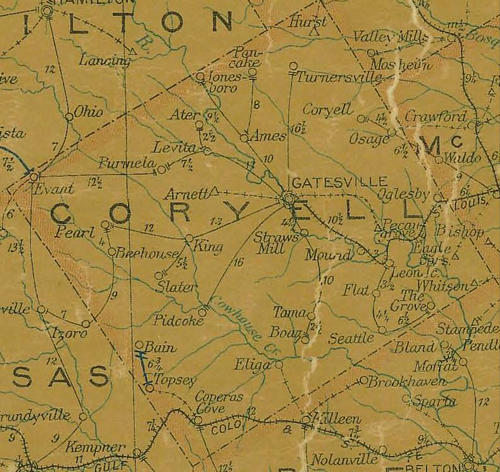|
|
The
Army, both in its absence and its presence, has had a big impact on
Coryell County
over the years.
The establishment of Fort
Gates on the Leon River in 1849 is what helped stimulate settlement
of the area as folks in Bell,
Burleson, Milam
and Washington
counties began to move into the eastern and southern parts of Coryell
County. Hostile Indians wisely steered clear of the vicinity.
The military abandoned the stockaded garrison (one of the few Hollywood-style
military posts ever actually built in Texas) in March 1852, but the
settlers drawn by the protection it had offered did not. By the 1860s,
some of the countyís early settlers had moved westward, building cabins
near what soon became the community of Pearl.
With the soldiers gone, and most of Texasí fighting men tied up in
the Civil War, the Comanches felt free to raid all along the stateís
western frontier. Texasí Confederate state government fielded companies
of Rangers to patrol the outlying counties, but they couldnít be everywhere
at once. |
 |
Comanche Warriors
by George Catlin
Courtesy of www.georgecatlin.org |
Thatís how things
stood on April 26, 1863 when a Comanche raiding party came up on a
settler named Steven Williamson, who lived several miles southeast
of Pearl.
When Williamson didnít come home that night, worried family and friends
went looking for him. They found his arrow-studded body lying near
a large tree that he may have tried to use for cover. The Indians
had scalped him and then pinned his thighs together, a sign that he
had defended himself gamely. Likely he wounded or killed some of his
attachers before they overpowered him.
His family carried his body home in the back of an ox-drawn wagon,
built a coffin, lined it with black calico and took him to the southern
part of the county near the community of Eliga for burial.
Years
later, Gordon Shook, Williamsonís great-grandson, could still find
what was left of the liveoak where his relativeís body had been left
by the Indians and posed for a photograph there. Charles E. Freeman
used the image in his book, ďA History of Pearl, Texas.Ē Gordon Williamsonís
grandfather, J.W. Shook, in 1875 had settled the land where the attack
had occurred.
Freeman also included in his book a couple of accounts from Coryell
County oldtimers who lived through those bloody days.
Mrs. W.W. Robinson remembered a time when she was a little girl that
she and her father just missed a run-in with Comanches. During the
week, she and her brother John stayed at her uncle Andy Boneís place
on Cowhouse Creek so they could attend a one-room school at King.
One Friday, her father Eli Williamson (whether he was related to the
late Steven Williamson was not mentioned in the book) came to pick
them up for the weekend. Her brother rode his own horse while she
sat behind her father on his horse. Not far from their home on Beehouse
Creek, her father spotted a group of Indians before the Indians saw
them.
Yelling for his daughter to hang on, Williamson wheeled his horse
and galloped off in the opposite direction. They made it home safely,
but it was a scare she never forgot.
Coryell
County residents had to stay alert for prowling Indians for several
years more. Dallas Edmondson later told of a Comanche horse-stealing
foray down Beehouse Creek in 1871. The Indians missed his horses,
which he had out grazing, but they made off with some others.
Though he died violently, Steven Williamsonís body rested in peace
until World War
Two broke out and the Army decided to return to Coryell
and surrounding counties. This time, of course, the military wasnít
moving in to protect residents from hostile Indians. The Army needed
a lot of open land for tank and artillery training.
The Army bought thousands of acres, including the area where Williamson
had been buried. Some 300 families had to give up their land and move.
Any grave on the soon-to-be military reservation that could be located
was dug up and reinterred, but even with the help of surviving family
members, Williamsonís burial site could not be found. So far as is
known, it has never been located.
© Mike Cox
"Texas Tales" January
27, 2011 column
More Columns |
 |
|
|
